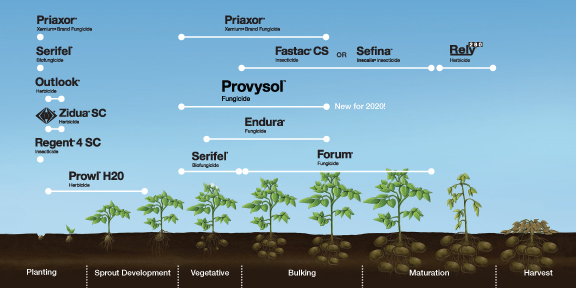When it comes to potato diseases, late blight seems to get all the attention, thanks in large part to a little historical blip known as the Irish Potato Famine. Perhaps that’s as it should be; late blight still manages to rear its ugly head and occasionally wreak havoc on the potato industry nearly two centuries later.
However, its cousin and partner in crime, early blight, has the potential to be just as devastating to a modern potato crop. That’s why BASF is focusing so much attention on promoting its Provysol product to farmers and agronomists. First approved for use on commercial potatoes in 2020, Provysol has exhibited excellent control — both in trial and field conditions — of early blight, as well as against brown spot and black dot.
“The last several years, Provysol has performed very well in high-pressure research trials,” says Curtis Rainbolt, a technical service representative for BASF who works with potato growers and processors throughout the Pacific Northwest. “And on the marketable acres where it was used in 2020, we saw very good results. Growers are happy with the level of disease control.”
How It Works
Provysol is an isopropanol azole chemistry powered by BASF’s fungicidal active ingredient Revysol. Engineered with a flexible molecule, it quickly penetrates plants for fast, long-lasting control. The unique isopropanol azole bridge allows the Revysol molecule to customize its shape, allowing for tighter binding at the enzyme site of action, combating diseases like early blight in potatoes, Cercospora leaf spot and powdery mildew in sugarbeets, and early and late leaf spot in peanuts.
Through the real-life trials the product has been run through on potato acres, Rainbolt says growers and agronomists have determined that it is most effective when applied early in a grower’s spray program. It delivers early protection that sets up the rest of the program for long-lasting control and success.
Using Provysol
Products with effective fungicidal action against early blight aren’t exactly new; several effective products have been on the market for years. The issue, Rainbolt says, is that the pathogen has developed some level of resistance in many growing areas.
“The biggest reason we wanted to get Provysol on the market is for resistance management,” says Rainbolt. “The industry has been heavily reliant on SDHI and Group 7 chemistries. Those are still effective, but if we stick with them too much, we risk reduced sensitivity with early blight and brown spot. That’s why we’re excited to introduce Provysol to fungicide programs, offering good performance and resistance management.”
For the most effective disease control, Rainbolt recommends growers in the Northwest incorporate Provysol into their spray programs early, right around row closure, then a second application 14 days later.
“To do the best job against early blight and brown spot, it’s best to use your strongest products earlier in the fungicide program,” he says. “After row closure, you get a microclimate under the crop canopy where the disease is more able to take hold and develop. If you make that first application just prior to row closure, you get good coverage for the whole plant.”

Better All the Time
BASF continues to work with growers, processors, agronomists and researchers to make Provysol as effective and easy to use as possible for on-farm use. A team works continuously to resolve MRL issues with officials in export markets to allow for the product’s use on even more potato acres. Testing has proven its effectiveness via ground, air or chemigation. This year, the label was updated to allow nearly all rotation crops to rotate immediately behind potatoes treated with Provysol.
“The target is always the grower when we introduce new products,” says Ken Deibert, a BASF technical service representative based in the Red River Valley of Minnesota and North Dakota. “Obviously, he’s the end user. If it’s not performing to grower expectation, it’s not a product we’re interested in bringing forward.”
“We always keep working to fine-tune all our products,” says Rainbolt. “As we talk to different growers and crop consultants, we’re continually looking at different ideas to make sure we’re not missing out on a better way to use the product.”
To learn more about how Provysol can fit into your fungicide program, click here or contact your local BASF representative.